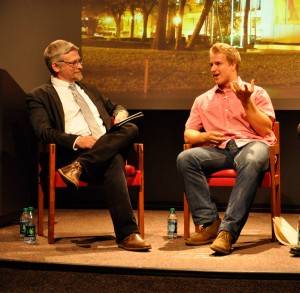Social media crucial for athletes’ images
Sunsets, TMZ and whether or not USC quarterback Matt Barkley highlights his hair were just a few of the topics discussed at the panel Communicating with the Media on Monday.
USC’s branch of national honor society Lambda Pi Eta hosted the discussion delving into athletes’ interaction with the press and social media.

Sports talk · Dan Durbin, director of Annenberg Institute of Sports, Media and Society, and quarterback Matt Barkley, a junior majoring in communication, discussed on Monday athletes’ interactions with the media. - Lisa Parker | Daily Trojan
Tim Tessalone, USC’s sports information director, began the discussion by contrasting the sports journalism of today with the field when he first started working for USC in 1979.
“Media were almost like lapdogs to athletes back then,” Tessalone said. “Athletes were idols. They were on a pedestal, and anything bad that happened, the media looked the other way.”
Tessalone said now anything athletes do or say could be criticized and analyzed by the media.
Becoming a public figure is something Barkley, a junior majoring in communication, said he has struggled to learn how to handle.
“You really have to watch what you say at all times because you never know who is going to snap a picture,” Barkley said. “And anything you see on the Internet is there forever.”
Dan Durbin, director of the Annenberg Institute of Sports, Media and Society, said part of the reason why student-athletes face so much media scrutiny is because of the notoriety of USC.
“USC is one of the two or three marquis sports institutions in all of Southern California, including professional teams,” Durbin said. “You [student-athletes] are a sports star in Southern California whether you want to be or not.”
Finding a balance between being a normal college student and a semi-professional athlete is something Barkley said he deals with through Twitter.
He not only tweets in support of his team after football games, but also posts tweets about computers and “geek stuff,” Instagram pictures of sunsets and even settles rumors about his natural blond hair.
“I like to let the fans see a part of me that they wouldn’t normally see unless they were around Heritage Hall all the time,” Barkley said.
Barkley’s Twitter can also be a tool for official USC sports communication, Tessalone said.
“We had him [Barkley] tweet when we hired one of our assistant football coaches, and he broke the news via Twitter,” Tessalone said.
Athletes’ social media image can be important to more than just their portrayal in the press. For Barkley, it could make or break his chances to win the Heisman Trophy next year, Durbin said.
“It’s a political campaign, it’s a beauty contest — you have to look pretty at the right times,” Durbin said.
Just as Barkley has had to learn to deal with the media in his college experience, students who attended the event said they learned from his commentary.
“It was a fantastic learning experience to get a great point of view from someone inside the Trojan sports family,” said Juliann Johnson, a freshman majoring in public relations. “It’s much different from what I expected.”
Annenberg students also said they felt the event augmented their journalism education.
“I appreciate the opportunity Annenberg is giving the audience to learn about sports, social media and journalism,” said Alyssa Nakamoto, a freshman majoring in print and digital journalism.
Though his football career forced Barkley to become aware of his image on social media much sooner than his peers will become aware of theirs, he said the experience is something everyone will have to go through.
“The number one rule on the team is to protect the team, and if you have that in mind when you are on your phone or computer, you know if something you are going to send out is going to hurt the team,” Barkley said. “It makes you aware; you have to be on your guard and be careful. Your words are immortalized now.”
